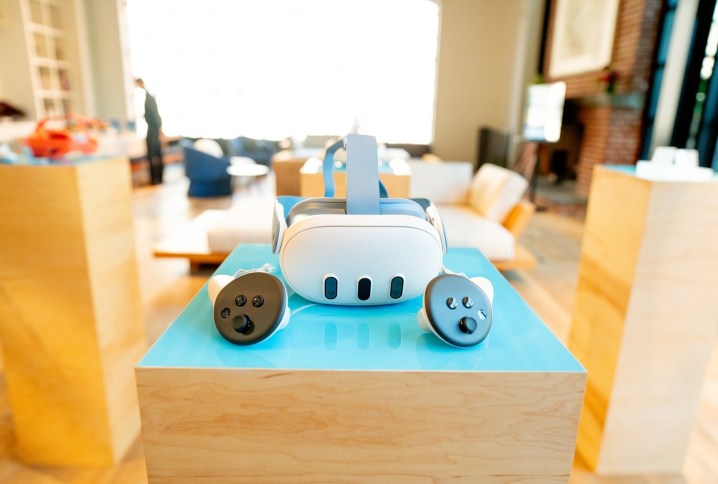
Meta has come a long way from its first foray into VR headsets. It has been just four years since the launch of the original Oculus Quest. Since then, the brand has experimented with names, features, and modes of reality, but it has always stayed at the top of the best VR headset ranking. It now prepares to introduce to the market, what it calls the first mainstream headset built for mixed reality, the Meta Quest 3.
While the hardware has been around for just a few years, Meta says it has been developing VR software for approximately a decade and has invested hundreds of millions of dollars in third-party content. This will allow there to be an extensive library already available for users that is already compatible with the new device, in addition to upcoming titles and programs.
I recently spent the afternoon at an art space in New York City, learning about and handling the Meta Quest 3. After seeing its mixed reality prowess in action, I’m certain this is the futuristic concept we’ve known for some time brought to life.
Specs
| Meta Quest 3 | |
| Dimensions | 7.2 x 6.7 x 3.9 inches |
| Weight | 1.14 pounds |
| Processor | Qualcomm Snapdragon XR2 Gen 2 platform |
| Display | 2 LCD displays, 2064 x 2208, 90Hz, 120Hz |
| Tracking/ Sensors | 6 advanced camera sensors, 6-DoF |
| Storage | 128GB or 512GB |
| RAM | 8GB |
| Touch | Touch Plus controllers |
| Eye Tracking | No |
| Audio | Integrated stereo speakers and mic, 3D spatial audio |
| MR Sensors | 2 RGB cameras |
| Battery life | 18W power adapter and power cord |
| Connectivity | Wi-Fi 6E, Bluetooth 5.2, BLE |
| Price/Availability | Starting $500, preorder Sept. 27, Ships Oct. 10 |
Design

Externally, the Meta Quest 3 is simplistic in its design. It is even more compact and inviting than the prior models with a triple-loop motif in the front, alluding to its mixed-reality functionality. Two loops house its main camera lenses and one is decorative. The headset is white but has peach, blue, and gray options for padding and straps. Meta notes that the options are intended to be inviting to those who might be exploring mixed-reality headsets for the first time. Similarly, the velcro straps are intended to be easy to maneuver and operate.
Having tried headsets on several times for different demos, I ultimately came to the decision that Meta Quest 3 isn’t very heavy at approximately 1.14 pounds. The first attempt just felt so because it wasn’t adjusted well to fit my large hair.
The velcro straps go vertically along the top strap and horizontally across the back and would probably be best set before putting the headset on for a comfortable fit. For other attempts, I put the headsets on myself without adjusting and had no issues.
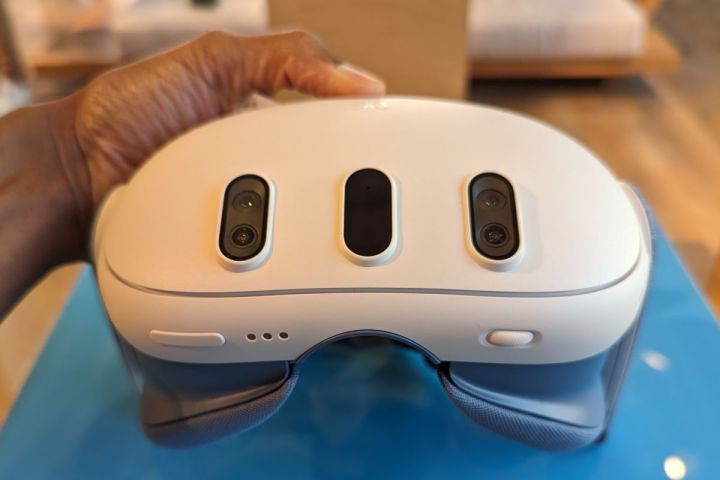
I didn’t test this feature with the headset on, but the Meta Quest 3 does include lens adjustment and depth adjustment as customization options for fitting. There is a lens distance adjustment wheel on the bottom right side of the headset, where you can visibly see the movement of the lenses. It allows you to mechanically space the lenses between 58 and 70 millimeters and to adjust the interpupillary distance (IPD) between 53 and 75 millimeters.
Notably, the Meta Quest 3 does not include eye tracking like its predecessors; which Meta says was intentional to keep its price point lower and to set it apart as a mixed reality option, especially since the Meta Quest 2 and Meta Quest Pro will remain in the brand’s device line up for the time being.
Display

The Meta Quest 3 optics setup includes dual LCD displays at 2064 by 2208 resolution, 25 ppd, and 1,218 ppi per eye. Combined with Meta’s Infinite Display optical stack, the headset offers more realistic graphics compared to the Quest 2. Additional specs include 90Hz and 120Hz refresh rate options and a field of view that extends 110 degrees horizontally and 96 degrees vertically, notably 15% wider than Quest 2. The pancake optical stack lenses used for the Meta Quest 3 are 40% slimmer than those on prior models with sharpness increased by 25%.
I didn’t have any issues in terms of visual quality. As a contact lens wearer, I had a solid baseline and made no adjustments to the headset lenses. This was a plus since I used different headsets for different demos. I found the mixed reality experiences that existed within open spaces to be of exceptional equality. Some of the fully immersed experiences were a different story. While I can see the rendering improvements over much older headsets, VR is still not on the level of, well, reality.
Controllers
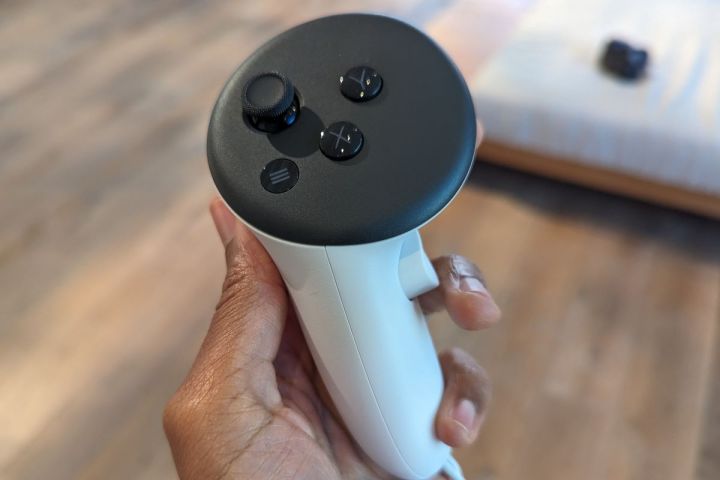
The Meta Quest 3 controllers have received an upgrade from the tracking on older controller models like the Meta Quest 2, which have had some challenges. The new Touch Plus controllers feature tracking based on AI algorithms and an IR sensor. They are also 40% thinner in the front in conjunction with the Pancake optics, having an ergonomic, ring-free design with Y-shaped hand straps. Their buttons and triggers are placed strategically for the best handling. There are triggers on the inner and outermost grips, X and Y buttons on the inner sides of the control pad, and a small joystick and menu button left of the main keys.
I was a little rusty on my gaming buttons, but it wasn’t a challenge to navigate the experiences I tested overall. With some experiences, it likely was a matter of game difficulty mixed with troubleshooting. Some called for me to switch from using the controllers to using my hands to direct the game.
The controllers are a little over a quarter of a pound heavy and feature TruTouch variable haptics feedback to aid with in-experience realism. They each come with disposable AA batteries, which can be swapped out for rechargeable batteries to pair with the Meta Quest 3 charging dock. Other (sold separately) accessories for the controllers include the Meta Quest 3 elite strap and Meta Quest active straps.
Mixed reality experience

The Meta Quest 3 mixed reality experiences really hit the nail on the head for me. The first experience I tried was one called First Encounters. Once set up in the headset I was met with a spaceship a few paces in front of me while other reviewers tested in their demo stations close by. My controllers turned into power guns and several fuzzballs began bouncing around before exploding moments later. It took me a moment to realize the objective was to shoot the fuzzballs, which were the aliens that needed help being boarded back on their ship.
The mission was timed and as I spun about, fuzzballs appeared from every corner of my demo station that was set up like a living room, underneath cushions and coffee tables, and behind cabinets. Once I got the hang of it I was shooting with both guns and catching the fuzzballs before they could fully materialize. Eventually, time ran out, the spaceship latch closed, and it departed. I was able to save about 56 out of 100 aliens. Despite being a cartoon-style game, I was convinced that I could pick up my phone and record what was happening. It was that immersive.
First Encounters is a simple game intended to get you accustomed to mixed reality, but as you can see, it sucked me right in. It ships with the Meta Quest 3 headset.
Another mixed reality demo I tried was BAM!, a multiplayer game that was also very fun to get into. The objective of this particular segment is to capture the crown and get 5,000 points. The avatars are battle robots in a steampunk-style arena that can punch, shoot, bomb, and release a slew of attacks on one another, gathering points toward the winner. It reminded me of Super Smash Bros, competitive and highly entertaining.
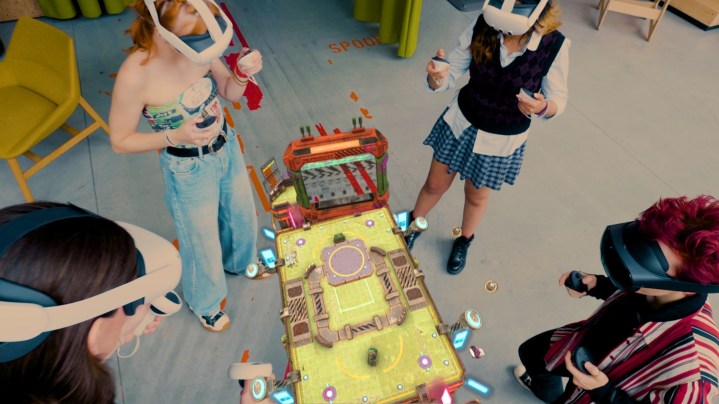
In the game, each player can adjust their arena to their preference, moving it in size, height, and space. It was likely amusing on the outside, seeing two people actively smack-talking each other about a game without actually seeing the game. I can only imagine what was going through the minds of onlookers.
I also demoed some more enclosed VR options. One called Samba De Amigo is reminiscent of Just Dance. The controllers turn into maracas, and you hit the directions to follow the dance moves. This game, in particular, allows you to experience the haptic feedback in the controllers as the maracas shake.
The Stranger Things: Tender Claws experience was also enclosed VR and uses your hands instead of controllers. I didn’t get too far in this experience as it included encounters with unsteady heights, which was a no-go for me. However, switching between immersive VR and pass-through mixed reality experiences is as easy as double-tapping the side of the headset. Using this motion allowed me to get back to a more comfortable experience.
Meta has also detailed a number of titles that will be available for the Meta Quest 3 upon their release, including Asgard’s Wrath 2, Assassin’s Creed Nexus, and Ghostbusters: Rise of the Ghost Lord.
In addition to games, Meta offers several fitness and wellness experiences, with Les Mills Bodycombat being an example. The Meta Quest 3 can also project out as a home theater for movies and TV.
The Meta Store already hosts over 500 mixed-reality and VR experiences, accessible to the Meta Quest 3 at launch, with an additional 100 new titles being introduced by the end of the year, and 50 of those titles being updated with mixed-reality features. The brand will also introduce Xbox game compatibility for the Meta Quest 3 later this year, in addition to Meta Quest for Business at the end of October.
Performance and battery life
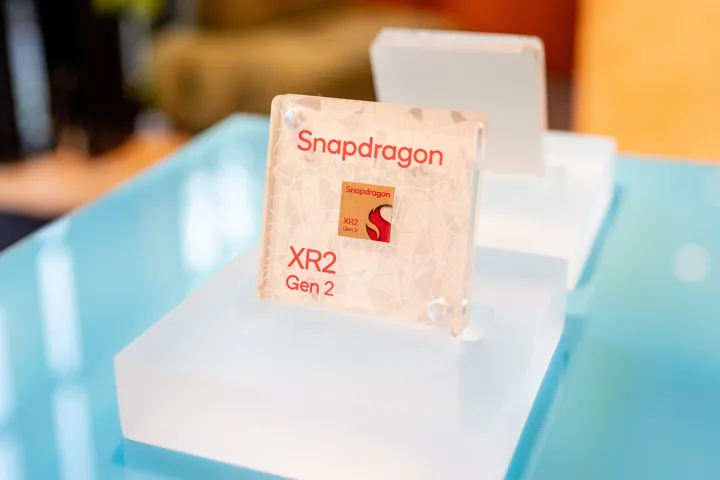
The Meta Quest 3 is powered by the Qualcomm Snapdragon XR2 Gen 2 chipset that enables its graphics performance, fast load times, and seamless gameplay. Meta forwent eye-tracking on this model and opted for an extensive camera-tracking setup, which especially assists in mixed reality. It also helps with automatic mapping and boundary setting of spaces that will be used for experiences. The headset includes six advanced tracking camera sensors, two RGB mixed reality camera sensors, and a depth projector.
The mixed reality functions within the Meta Quest will enable a new feature, the brand calls Augments, which will allow you to place digital objects in your space and interact with them as if they are real. Similar to widgets, some can remind you of your next workout, and some can just be decorations that will show up every time you enter your mixed-reality space. Meta has collaborated with iHeartRadio on a music player Augment and plans to introduce more partnerships and experiences.
The Meta Quest 3 supports an overall battery life of 2.2 hours with average use. It charges from 0% in two hours with its 18-watt power adapter, which is included in the box with a power cord. The Meta Quest 3 charging dock is an optional accessory, which also charges its controllers.
Price and availability
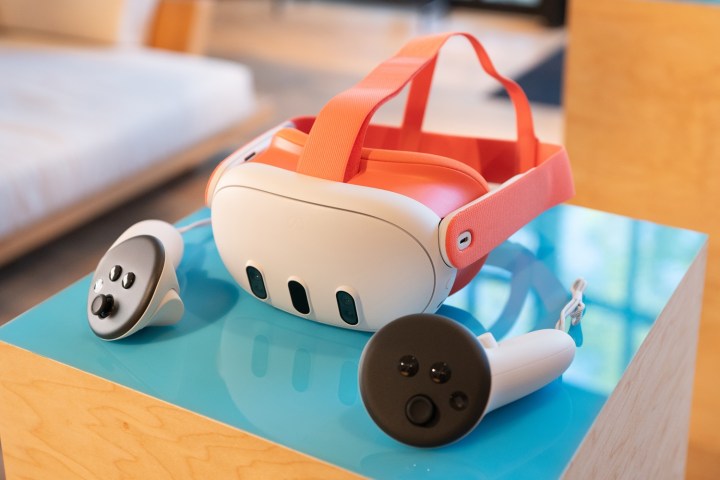
The Meta Quest 3 will sell starting at $500 in its 128GB version and $650 in its 512GB variant. Preorders for the mixed reality headset will begin September 27, while the device will ship October 10. The Quest 3 will be available through the Meta Store in 23 countries and Amazon in the U.S., Canada, U.K., Germany, Japan, and France. U.S. retailers include Best Buy, Target, and Walmart. The headset will also be available at select international in-store retailers.
The brand is also offering a bundled deal for the Meta Quest 3 128GB version, including Asgard’s Wrath 2 and a six-month Meta Quest+ subscription with purchase.
Editors’ Recommendations




